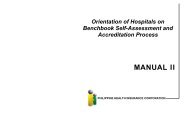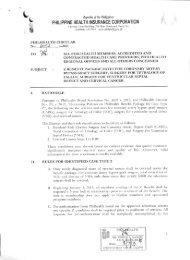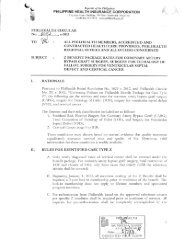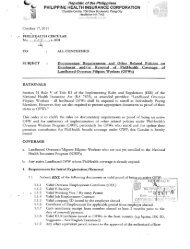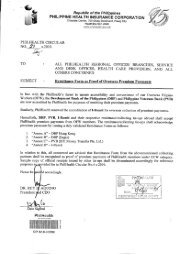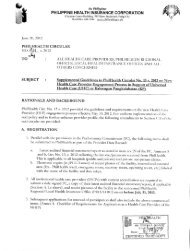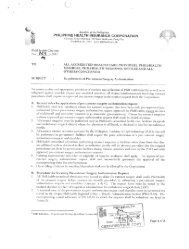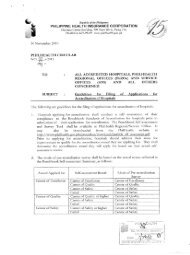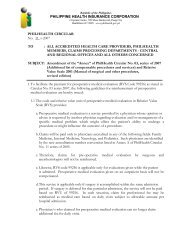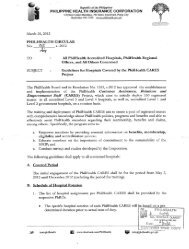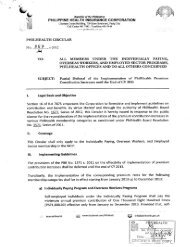primary care benefit 1 - Philippine Health Insurance Corporation
primary care benefit 1 - Philippine Health Insurance Corporation
primary care benefit 1 - Philippine Health Insurance Corporation
You also want an ePaper? Increase the reach of your titles
YUMPU automatically turns print PDFs into web optimized ePapers that Google loves.
physiology of lactation; the establishment and maintenance of lactation; the proper<br />
<strong>care</strong> of the breasts and nipples; and such other matters that would contribute to<br />
successful breastfeeding. Mothers should be encouraged to exclusively breastfeed<br />
their babies from birth up to 6 months. Continued breast feeding along with<br />
appropriate complementary foods is recommended up to two years and beyond.<br />
Education should be given during the prenatal, perinatal and postnatal consultations<br />
and/or confinements of the mothers or pregnant women in a health institution.<br />
5. Periodic clinical breast examinations – This examination should be performed once a<br />
year on patients 50 years old and older. This may also be offered among younger<br />
patient groups identified to have a high risk for breast cancer according to the<br />
provider.<br />
Patients with religious and cultural barriers/prohibition may sign a waiver not to avail<br />
this service.<br />
6. Counselling for lifestyle modification – This is focused on major health risk factors<br />
particularly tobacco use, unhealthy diet, physical inactivity, and alcohol use, and,<br />
include other relevant risk factors such as but not limited to the following:<br />
hypertension, high blood sugar, overweight and obesity, and impaired lung function.<br />
All patients seeking consult should be advised.<br />
7. Counselling for smoking cessation – All patients seen in the clinic should be asked<br />
about smoking and/or second hand exposure. Patients should be educated on the<br />
hazards of smoking and encouraged to stop.<br />
8. Body measurements – Pediatric patients should have their weight and height<br />
measured and recorded for each visit. All adult patients (20 years old and above)<br />
should have their waist circumference (at the narrowest point, usually just above<br />
the umbilicus) and hip circumference (at the widest point) measured and their<br />
waist‐hip ratio (WHR) calculated.<br />
9. Digital Rectal Examination – This may be performed for men 50 years old and older<br />
after discussion of the nature and risk of prostate cancer and the risks of, <strong>benefit</strong>s<br />
of, and alternatives to screening. This may also be performed in patients 50 years<br />
old and older along with fecal occult blood test to screen for colorectal cancer.<br />
Patients with religious and cultural barriers/prohibition may sign a waiver not to<br />
avail this service.<br />
B. Diagnostic Examinations<br />
Request of the following diagnostic examinations still depends on the clinical judgement<br />
of the physician based on his/her up to date knowledge and circumstance of each case.<br />
16



